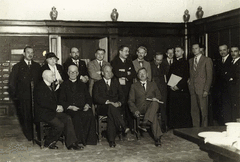The History of the German Research and Culture Institutes in Rome (20th century)
A cooperative project
The four German foreign institutes based in Rome – the German Archaeological Institute, the German Historical Institute, the Bibliotheca Hertziana and Villa Massimo – have initiated a research project which will examine cross institutional history against the backdrop of major political and societal upheavals in the first half of the twentieth century (1918–1960). Rome will play a vital role in this shared history of the German foreign institutes. The city was a focal point of internationalization within the humanities, a place of exchange, interdependence and competition between the fields of science (Wissenschaft) and politics. Two PhD students of contemporary history, Franziska Rohloff and Dorothea Wohlfarth, will work on their theses within the cooperative framework of the project.
Project supervisors
Prof. Dr. Martin Baumeister, German Historical Institute
Dr. Joachim Blüher, Villa Massimo
Prof. Dr. Ortwin Dally, German Archaeological Institute
Prof. Dr. Sybille Ebert-Schifferer, Bibliotheca Hertziana
Prof. Dr. Tanja Michalsky, Bibliotheca Hertziana
Prof. Dr. Tristan Weddigen, Bibliotheca Hertziana
Coordination
Prof. Dr. Martin Baumeister, German Historical Institute
Prof. Dr. Ortwin Dally, German Archaeological Institute
Scientific staff
Franziska Rohloff, M. A., M. Ed.
Dorothea Wohlfarth
Project duration
2017–2019
Cooperation Partners
Bundesministerium für Bildung und Forschung
Unione Internazionale degli Istituti di Archeologia, Storia e Storia dell’arte in Roma
Forschungscluster 5: „Geschichte der Archäologie“ des Deutschen Archäologischen Instituts (DAI)
Financed by
Auswärtiges Amt
Max Weber Stiftung
Contact
Franziska Rohloff M.A., M.Ed.
Via Valadier 37
00193 Rome
Italy
+ 39 06 66049257
franziska.rohloff[at]dainst.de
Dorothea Wohlfarth
Via Valadier 37
00193 Rome
Italy
+ 39 06 66049257
dorothea.wohlfarth[at]dainst.de
During the 19th century Rome was transformed into a unique international centre for research within the humanities. A prominent role was played by classical studies, history and art history, for which the Eternal City had enormous appeal; as a hub of Western civilisation with its historical and cultural heritage; as a central location for the storage, transmission and presentation of knowledge and culture; and as a laboratory for the development of key institutions, such as archives, libraries and museums. The high density of artists from all over Europe, which had moved to Rome since the mid eighteenth century and were the first to strive towards founding national academies in the city, created a transnational, intellectual atmosphere of exchange.
Currently, the Eternal City hosts ten Italian and twenty-seven non-Italian academies, research and cultural institutions, which are associated within the transnational union 'Unione internazionale degli istituti di archeologia, storia e storia dell'arte in Roma'. Five of the twenty-seven non-Italian academies, research and cultural institutions are under German sponsorship. In addition to the Roman institute of the Görres Society, founded in 1888, the oldest German scientific institution abroad is the German Archaeological Institute, whose beginnings date back to 1829. The German Historical Institute was established in 1888, the Bibliotheca Hertziana, dedicated to art history studies, in 1913, and the current Villa Massimo German Academy Rome in 1910.
Three key questions frame the cooperation project: What did being a scientist (Wissenschaftler) mean in an extra-university, 'extra-territorial' German research and cultural institute? How did science (Wissenschaft) work when specific (cultural) political expectations were applied to its work? How did the members of the German foreign institutes cope with the challenges of acting as mediators between the German scientific community and the international, in particular Italian, scientific community?
The first focus of interest within the cooperative project therefore lies on personnel structures. It is hard to imagine that the ever-changing institutional framework under disparate political systems had no impact on institutional human resource policies. How did the institutes recruit junior research staff? Which role did gender or denomination play? How did this influence everyday life and work within the institutes? Were professional practices only changed in the course of the 1930s or have there been other, more deeply embedded, processes of change before and after? Questions regarding the career conditions and career opportunities of scientists working in extra-territorial research institutes, promise to present new findings.
The second key question area, however, focuses on the broad field of the relationship between science and politics. It is important to remember that the German research and cultural institutes based in Rome were seen and saw themselves as part of the German scientific landscape. Besides the support of a few private patrons, they were, after all, mainly financed and operated by the German state. In order to clarify who could influence the work, the purpose and the orientation of the German research and cultural institutes based in Rome from the outside, a comparative analysis of the legal status and the scientific organisational profile of the individual institutes is imperative. Other aspects to be discussed in the framework of the cooperation project concern concrete research practices: which continuities and fractures crystallize in view of the various political and social upheavals of the 20th century? Is it possible to identify significant or selective changes in research topics and agendas?
Due to the 'extra-territorial' location, members of the German research and cultural institutes based in Rome encountered seemingly ideal conditions to establish contacts between researchers and artists from all over the world. Therefore, the analysis of the structure, stabilisation and transformation processes of relational structures seems to be of great relevance for the cooperation project. As part of the cooperation project, the following six relationship structures will be examined in particular:
I. The relationship between the German research and cultural institutes in Rome
II. The relationship of the German research and cultural institutes in Rome with the German scientific community and the German scientific system
III. The relationship of the German research and cultural institutes with the hosting country (i.e. Italy) in general and with Italian academies in the field of humanities as well as Italian research and cultural institutes in particular
IV. The relationship of the German research and cultural institutes with the Vatican in general, but especially with humanities academies and other comparable institutes of the Vatican
V. The relationship of the German institutes with other foreign institutes based in Rome as well as with the larger scientific community
VI. The relationship between the German institutes and the German community in Rome
Bibliography:
- Joachim Blüher (Ed.), Villa Massimo. Deutsche Akademie Rom 1910–2010. Hundert Jahre Deutsche Akademie Rom Villa Massimo, Köln: Wienand 2011.
- Sybille Ebert-Schifferer/Marieke von Bernstorff (Eds.), 100 Jahre Bibliotheca Hertziana. Die Geschichte des Instituts 1913–2013, 2 Bde., München: Hirmer 2013 (Max-Planck-Institut für Kunstgeschichte 1).
- Reinhard Elze/Arnold Esch (Eds.), Das Deutsche Historische Institut in Rom. 1888–1988, Tübingen: Niemeyer 1990 (Bibliothek des Deutschen Historischen Instituts in Rom 70).
- Thomas Fröhlich, Das Deutsche Archäologische Institut in Rom in der Kriegs- und Nachkriegszeit bis zur Wiedereröffnung 1953, in: Michael Matheus (Ed.), Deutsche Forschungs- und Kulturinstitute in Rom in der Nachkriegszeit. Tübingen: Niemeyer 2007 (Bibliothek des Deutschen Historischen Instituts in Rom 112), pp. 139–179.
- Michael Matheus (Ed.), Deutsche Forschungs- und Kulturinstitute in Rom in der Nachkriegszeit, Tübingen: Niemeyer 2007 (Bibliothek des Deutschen Historischen Instituts in Rom 112).
- Marie Vigener, "Ein wichtiger kulturpolitischer Faktor". Geschichte des Deutschen Archäologischen Instituts im 20. Jahrhundert / Das Deutsche Archäologische Institut zwischen Wissenschaft, Politik und Öffentlichkeit, 1918 bis 1954. Rahden, Westf: Leidorf 2012 (ForschungsCluster 5, Geschichte des Deutschen Archäologischen Instituts im 20. Jahrhundert 7).
- Angela Windholz, Et in academia ego. Ausländische Akademien in Rom zwischen künstlerischer Standortbestimmung und nationaler Repräsentation [1750–1914]. Regensburg: Schnell & Steiner 2008.


